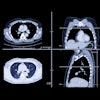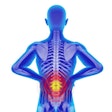Chronic stress appears to manifest as a detectable biomarker that can be seen on routine chest CT images using AI, according to research presented November 25 at RSNA 2025 in Chicago.
Zeroing in on the physiologic cascade of chronic stress, lead author Elena Ghotbi, MD, of Johns Hopkins University School of Medicine in Baltimore, MD, and colleagues explored the stress response as observed in the adrenal gland located at the top of the kidneys.
The group developed and trained a deep-learning AI model to measure adrenal gland volume and used it to analyze the routine chest CT scans of 2,842 participants (mean age, 69.3) of Exam-5 of the Multi-Ethnic Study of Atherosclerosis (MESA). With up to 10 years of follow-up data on the participants, the team correlated AI-derived adrenal volume index (AVI) with "clinically meaningful and relevant" outcomes.
“Our approach leverages widely available imaging data and opens the door to large-scale evaluations of the biological impact of chronic stress across a range of conditions using existing chest CT scans,” Ghotbi said in an RSNA statement.
The investigators tested the model on scans of participants whose adrenal glands were fully visualized in noncontrast chest CT exams, reporting a median adrenal volume of 9.6 across the cohort. They used multiplanar manual segmentations to train a Swin UNETR model in MONAI [Medical Open Network for AI], initialized with self-supervised pre-trained weights from 5,050 CTs and trained on 55 scans using DiceCELoss with patch-based augmentation.
They also assessed BMI, creatinine, hemoglobin, albumin, glucose, WBC, heart rate, and blood pressure to determine the measure of allostatic load, which is considered a cumulative burden of chronic stress. They then evaluated statistical associations between AVI and cortisol, allostatic load, and psychosocial stress measures, including depression and perceived stress questionnaires.
Overall, the authors found that participants with high perceived stress had 0.23 cm³/m² higher AVI compared with those with low stress, and that higher AVI was associated with greater cortisol, peak cortisol, and allostatic load. In addition, each 1 cm³/m² increase in AVI was linked to greater risk of heart failure.
 Left and right adrenal automated 2D and 3D segmentation in chest CT.RSNA
Left and right adrenal automated 2D and 3D segmentation in chest CT.RSNA
Unlike single cortisol measurements, which provide a momentary snapshot of stress levels, adrenal volume acts like a "biological barometer" of chronic stress, according to the researchers.
“This AI-driven biomarker has the potential to enhance cardiovascular risk stratification and guide preventive care without additional testing or radiation,” Ghotbi said.




















